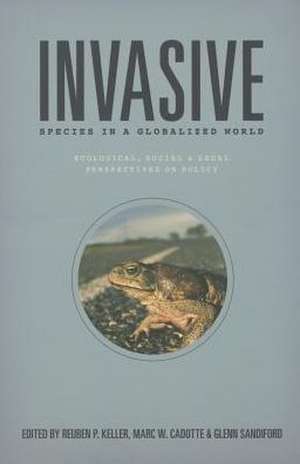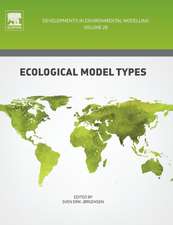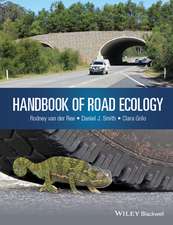Invasive Species in a Globalized World: Ecological, Social, and Legal Perspectives on Policy
Editat de Reuben P. Keller, Marc W. Cadotte, Glenn Sandiforden Limba Engleză Paperback – 24 noi 2014
Over the past several decades, the field of invasion biology has rapidly expanded as global trade and the spread of human populations have increasingly carried animal and plant species across natural barriers that have kept them ecologically separated for millions of years. Because some of these nonnative species thrive in their new homes and harm environments, economies, and human health, the prevention and management of invasive species has become a major policy goal from local to international levels.
Yet even though ecological research has led to public conversation and policy recommendations, those recommendations have frequently been ignored, and the efforts to counter invasive species have been largely unsuccessful. Recognizing the need to engage experts across the life, social, and legal sciences as well as the humanities, the editors of this volume have drawn together a wide variety of ecologists, historians, economists, legal scholars, policy makers, and communications scholars, to facilitate a dialogue among these disciplines and understand fully the invasive species phenomenon. Aided by case studies of well-known invasives such as the cane toad of Australia and the emerald ash borer, Asian carp, and sea lampreys that threaten US ecosystems, Invasive Species in a Globalized World offers strategies for developing and implementing anti-invasive policies designed to stop their introduction and spread, and to limit their effects.
Yet even though ecological research has led to public conversation and policy recommendations, those recommendations have frequently been ignored, and the efforts to counter invasive species have been largely unsuccessful. Recognizing the need to engage experts across the life, social, and legal sciences as well as the humanities, the editors of this volume have drawn together a wide variety of ecologists, historians, economists, legal scholars, policy makers, and communications scholars, to facilitate a dialogue among these disciplines and understand fully the invasive species phenomenon. Aided by case studies of well-known invasives such as the cane toad of Australia and the emerald ash borer, Asian carp, and sea lampreys that threaten US ecosystems, Invasive Species in a Globalized World offers strategies for developing and implementing anti-invasive policies designed to stop their introduction and spread, and to limit their effects.
Preț: 366.08 lei
Nou
Puncte Express: 549
Preț estimativ în valută:
70.05€ • 73.14$ • 57.97£
70.05€ • 73.14$ • 57.97£
Carte disponibilă
Livrare economică 10-17 martie
Livrare express 27 februarie-05 martie pentru 48.75 lei
Preluare comenzi: 021 569.72.76
Specificații
ISBN-13: 9780226166186
ISBN-10: 022616618X
Pagini: 416
Ilustrații: 10 color plates, 34 halftones, 15 line drawings, 13 tables
Dimensiuni: 152 x 229 x 25 mm
Greutate: 0.6 kg
Editura: University of Chicago Press
Colecția University of Chicago Press
ISBN-10: 022616618X
Pagini: 416
Ilustrații: 10 color plates, 34 halftones, 15 line drawings, 13 tables
Dimensiuni: 152 x 229 x 25 mm
Greutate: 0.6 kg
Editura: University of Chicago Press
Colecția University of Chicago Press
Notă biografică
Reuben P. Keller is assistant professor of environmental science at Loyola University Chicago and is coeditor of Bioeconomics of Invasive Species: Integrating Ecology, Economics, Policy and Management. He lives in Evanston, IL. Marc W. Cadotte is the TD Professor of Urban Forest Conservation and Biology at the University of Toronto Scarborough and coeditor of Conceptual Ecology and Invasion Biology: Reciprocal Approaches to Nature. He lives in Toronto, ON. Glenn Sandiford is an adjunct instructor in the Natural Resources and Environmental Sciences unit at the University of Illinois, Urbana-Champaign, and with the Center for Online Learning at Saint Leo University.
Cuprins
Chapter 1
Working across Disciplines to Understand and Manage Invasive Species
Working across Disciplines to Understand and Manage Invasive Species
R. P. Keller, M. Cadotte, G. Sandiford
Section 1 Introduction
Of Toads, Squirrels, Carps, and Kids: How Science and Human Perceptions Drive Our Responses to Invasive Species
Section 1 Introduction
Of Toads, Squirrels, Carps, and Kids: How Science and Human Perceptions Drive Our Responses to Invasive Species
Chapter 2
The Ecological, Evolutionary, and Social Impact of Invasive Cane Toads in Australia
R. Shine
Chapter 3
Chapter 3
A Tale of Two Squirrels: A British Case Study of the Sociocultural Dimensions of Debates over Invasive Species
P. Coates
Chapter 4
Chapter 4
Fish Tales: Optimism and Other Bias in Rhetoric about Exotic Carps in America
G. Sandiford
Chapter 5
“Sooper” Impact: Drawing the Attention of Kids to the Dangers of Invasive Species
M. Newman
Section 2 Introduction
Here They Come: Understanding and Managing the Introduction of Invasive Species
Chapter 6
Patterns of Live Vertebrate Importation into the United States: Analysis of an Invasion Pathway
C. Romagosa
Chapter 7
All in the Family: Relatedness and the Success of Introduced Species
M. Cadotte, L. Jin
Chapter 8
Reducing Damaging Introductions from International Species Trade through Invasion Risk Assessment
M. Springborn
Section 3 Introduction
Controlling the Bad: Reducing the Impacts of Established Invaders
Chapter 9
Evaluating the Economic Costs and Benefits of Slowing the Spread of Emerald Ash Borer
J. Bossenbroek, A. Croskey, D. Finnoff, L. Iverson, S. McDermott, A. Prasad, C. Sims, D. Sydnor
Chapter 10
Climate Change Challenges in the Management of Invasive Sea Lamprey in Lake Superior
J. Kitchell, T. Cline, V. Bennington, G. McKinley
Chapter 11
Ecological Separation without Hydraulic Separation: Engineering Solutions to Control Invasive Common Carp in Australian Rivers
Robert Keller
Chapter 12
Does Enemy Release Contribute to the Success of Invasive Species? A Review of the Enemy Release Hypothesis
K. Prior, J. Hellmann
Section 4 Introduction
Where to from Here? Policy Prospects at International, National, and Regional Levels
Chapter 13
From Global to Local: Integrating Policy Frameworks for the Prevention and Management of Invasive Species
S. Burgiel
Chapter 14
Developing Invasive Species Policy for a Major Free Trade Bloc: Challenges and Progress in the European Union
C. Shine
Chapter 15
There Ought to Be a Law! The Peculiar Absence of Broad Federal Harmful Nonindigenous Species Legislation
M. Miller
Chapter 16
Pathways toward a Policy of Preventing New Great Lakes Invasions J. Brammeier, T. Cmar
Chapter 17
Final Thoughts: Nature and Human Nature
G. Sandiford, R. P. Keller, M. Cadotte
G. Sandiford
Chapter 5
“Sooper” Impact: Drawing the Attention of Kids to the Dangers of Invasive Species
M. Newman
Section 2 Introduction
Here They Come: Understanding and Managing the Introduction of Invasive Species
Chapter 6
Patterns of Live Vertebrate Importation into the United States: Analysis of an Invasion Pathway
C. Romagosa
Chapter 7
All in the Family: Relatedness and the Success of Introduced Species
M. Cadotte, L. Jin
Chapter 8
Reducing Damaging Introductions from International Species Trade through Invasion Risk Assessment
M. Springborn
Section 3 Introduction
Controlling the Bad: Reducing the Impacts of Established Invaders
Chapter 9
Evaluating the Economic Costs and Benefits of Slowing the Spread of Emerald Ash Borer
J. Bossenbroek, A. Croskey, D. Finnoff, L. Iverson, S. McDermott, A. Prasad, C. Sims, D. Sydnor
Chapter 10
Climate Change Challenges in the Management of Invasive Sea Lamprey in Lake Superior
J. Kitchell, T. Cline, V. Bennington, G. McKinley
Chapter 11
Ecological Separation without Hydraulic Separation: Engineering Solutions to Control Invasive Common Carp in Australian Rivers
Robert Keller
Chapter 12
Does Enemy Release Contribute to the Success of Invasive Species? A Review of the Enemy Release Hypothesis
K. Prior, J. Hellmann
Section 4 Introduction
Where to from Here? Policy Prospects at International, National, and Regional Levels
Chapter 13
From Global to Local: Integrating Policy Frameworks for the Prevention and Management of Invasive Species
S. Burgiel
Chapter 14
Developing Invasive Species Policy for a Major Free Trade Bloc: Challenges and Progress in the European Union
C. Shine
Chapter 15
There Ought to Be a Law! The Peculiar Absence of Broad Federal Harmful Nonindigenous Species Legislation
M. Miller
Chapter 16
Pathways toward a Policy of Preventing New Great Lakes Invasions J. Brammeier, T. Cmar
Chapter 17
Final Thoughts: Nature and Human Nature
G. Sandiford, R. P. Keller, M. Cadotte
Recenzii
“Presents a convincing argument that policy development must proceed through better integration of science, policy, and public awareness. . . . The book’s crucial contribution is convincing readers that halting the spread of invasive species is daunting, but possible, with coordination and cooperation from many stakeholders. . . . Because Invasive Species is a blend of empirical studies, reviews, control methodology, historical accounts, and policy implications, all readers can get something out of this book. . . . The book will make the biggest contribution if read by policy makers or scientists charged with communicating science to policy makers. Although some academics would argue that a species’ origin does not necessarily predict its ecological or economic impact in its introduced range and that we should not demonize exotic species, the authors illustrate the potential for a handful of species to undermine the functioning of critical habitats. Keller and his colleagues powerfully argue that the fight against invasive species is a worthy struggle.”
“This excellent book examines a complex issue, helping bridge the gap between policy and science, and steering global action against invasive species based on a synthesis of the relevant disciplines. The final paragraph stresses that although we have the knowledge and tools to alter the patterns and impacts of invasions, to progress we need to address the principal challenges, which are cultural rather than technical.”
“Any invasion biologist would find much of interest in this book, with its intriguing mix of topics, many a little off the well-trodden tracks of invasion biology.”
“Policy makers, researchers, and students in ecology, particularly population and community ecology, will find this book an excellent source of information about invasive introduced species. . . . Recommended.”
“There is much to be admired in the book. It seeks to light a little fire under a pot that has been very hard to bring to a political boil: how to get better laws in the United States to control species introductions for groups not currently regulated. . . . A good book, well worth reading.”
“Cane toads in Australia, Asian carp in America and grey squirrels in England—Keller and Cadotte’s book, edited with environmental writer Sandiford, helps bridge the gap between ecologists, economists, and legal scholars sharing similar anxieties over invasive species regulation and its absence. These professional cross-purposes have stymied effective administration of challenges that, as the book’s title suggests, are worsening in a globalized world.”
“While other works have highlighted the current status of invasion ecology, this book seeks to put an emphasis on management and policy that can be created to begin to mitigate the many issues of biological invasions. Satisfying, exciting, and incorporating an astonishing variety of scholars and traditions, Invasive Species in a Globalized World provides an adequate background in invasion ecology and then steers the topic toward policy in an effective way. This is a crucial and currently lacking segment along the pathway from research to action.”
“Invasive Species in a Globalized World is an exciting, multifaceted approach to an overwhelming, urgent problem. It has something for everyone: ecology of important invaders, updates on management efforts, costs of invasions and management, politics and laws, and social attitudes about invasions and their impacts.”
“Although much progress has been made in studies of biological invasions in recent years, effective management of invasive species remains a daunting challenge. What is clear is that effective responses demand insights from multiple disciplines. The essays collected in this book provide a very helpful primer of progress and perspectives in this regard.”













